How to Make a Moss Smoothie to Transform Your Vivarium
Have you ever marveled at vivarium artists' ability to blanket entire backgrounds and hardscapes with a lush, beautiful green carpet?
One common technique for achieving this effect is using a 'moss smoothie.' Don’t worry, this isn't something you drink.
In this article, we'll explore what a moss smoothie is, when and how to use it for best results, and of course, how to create your own.
Let's dive in.
What’s a moss smoothie?
In essence, a moss smoothie is a blend of finely chopped moss and water, applied to vivarium hardscapes.
This straightforward process takes just a few minutes, enabling you to spread it easily throughout your vivarium for a lush landscape.
However, patience is key. Significant growth is typically noticeable after about six weeks, with the moss becoming dense by around six months.
Once fully grown in, it seamlessly blends into the environment, offering a more natural look compared to manually adding clumps of moss (although that approach works fine too!)
When Is it appropriate to use?
It's important to note that this method is best suited for tropical vivariums, as there isn’t a moss (that I know of) that works well for temperate or arid setups.
Moss smoothies are excellent for covering natural hardscapes like wood, cork bark, and porous rocks, as well as moisture-absorbing materials like hygrolon or similar substances, provided they remain adequately moist.
However, they're less effective on synthetic items such as Great Stuff backgrounds and faux rocks due to their tendency to dry out quickly.
If you’re looking for ground cover, I would skip this method and simply use moss sheets.
How to Make A moss smoothie
Start with a moss that suits your vivarium's needs.
Hardy mosses like Java moss, Christmas moss, and Weeping moss are excellent choices due to their resilience and availability. Riccia, although a liverwort, can also be used effectively.
To create your moss smoothie, simply blend the chosen mosses with water until they are finely chopped but not liquefied.
Apply the mixture by pouring/splashing it in the desired areas, or use a small paintbrush to dab it in specific areas for more control.
The moss will establish itself fairly quickly. Growth can be observed within four weeks, with denser coverage developing around six weeks.
Mixing various moss types allows the strongest ones to thrive based on their preferred light levels and location in the vivarium, contributing to a diverse and vibrant scape.
Using a Premade mix
If you prefer, or have a large setup to cover, another option is to purchase premade moss mixes.
Premade mixes often have a mix of several types of mosses. This can range from tropical mosses, temperate mosses, sphagnum moss, fern spores, liverworts, and various small plant seeds.
These mixes may come in either a wet slurry or a dried, finely milled powder form.
Here are a few mixes to check out:
Dusk Moss from GlassBox Tropicals
Live Moss Slurry from NEHerp
Wet Moss Mix from FrogDaddy
Graffiti Moss Mix from Fern’s Frogs
Tips for success
Lastly, let's discuss a few key takeaways to maximize your success.
Lighting
You will get best results with bright lighting. Lower lighting levels will still work, but will take longer to see results.Humidity
Maintain a humid tropical environment in your vivarium that doesn't dry out, either by starting with a sealed-off vivarium or using a misting system.Misting
Consistently mist the moss at least twice a day for the first two weeks, and then at least once a day afterwards. This is of course much easier with a misting system.Surfaces
Apply the moss smoothie only on natural wood decor, rocks, and other surfaces that retain moisture well.Water
Use purified water, such as RO water or distilled water, for optimal results.
Conclusion
Creating a moss smoothie can be a rewarding and effective way to achieve lush greenery in your vivarium.
Whether you opt for DIY blends or premade mixes, proper lighting and humidity are crucial for success. Remember to mist regularly, use purified water, and choose natural hardscape materials for optimal growth.
With patience, you can create a stunning and vibrant vivarium scape that will delight both you and its inhabitants.




